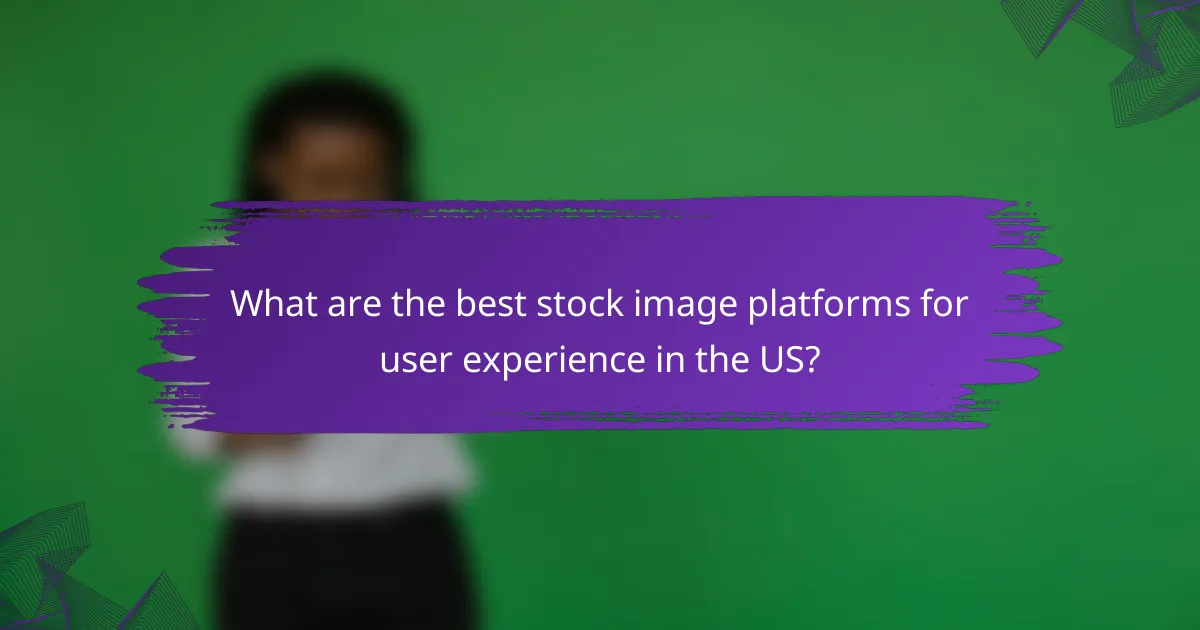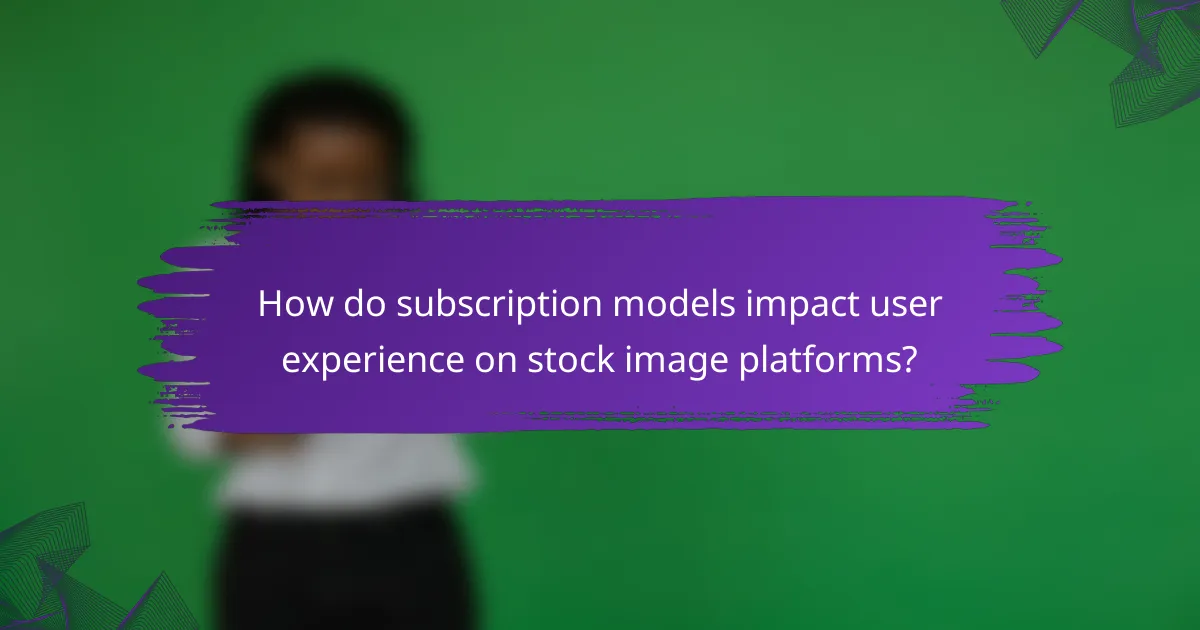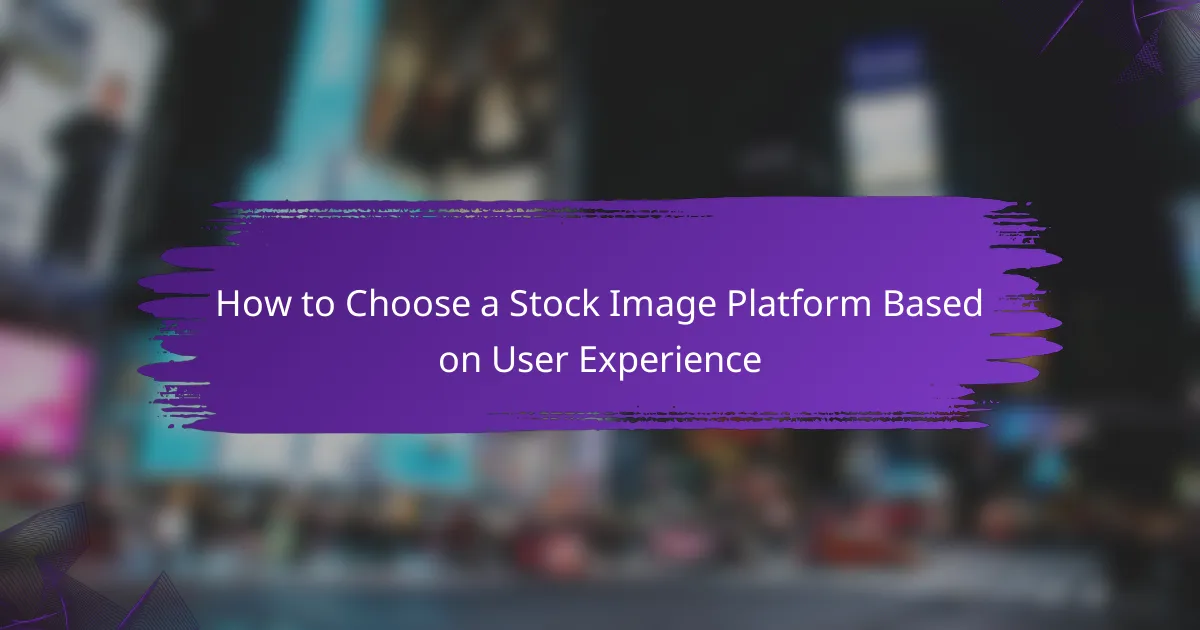Choosing the right stock image platform is essential for a seamless user experience, as it hinges on intuitive navigation, high-quality visuals, and effective search capabilities. Factors such as pricing, licensing options, and image variety play a crucial role in determining which platform best meets your needs. Additionally, understanding subscription models can help you assess access levels and content variety, ensuring you find a cost-effective solution that aligns with your usage frequency.

What are the best stock image platforms for user experience in the US?
The best stock image platforms for user experience in the US prioritize intuitive navigation, high-quality images, and efficient search functionalities. Users should consider factors such as pricing, licensing options, and the variety of images available to find the platform that best suits their needs.
Adobe Stock
Adobe Stock offers a seamless integration with Adobe Creative Cloud applications, making it a top choice for designers and creatives. The platform features a user-friendly interface that allows for easy searching and filtering of images based on various criteria, including orientation, color, and style.
Pricing is competitive, with subscription plans starting at around $29.99 per month for 10 images. Users can also purchase images on a pay-per-image basis, which is ideal for those who need occasional access without a subscription.
Shutterstock
Shutterstock is known for its extensive library of over 300 million images, providing a vast selection for users. The platform’s advanced search tools enable users to find images quickly, with options to filter by image type, category, and even contributor.
Shutterstock offers flexible pricing plans, including monthly subscriptions and on-demand packs, starting at approximately $49 for 10 images. This variety allows users to choose a plan that aligns with their usage frequency and budget.
Getty Images
Getty Images is a premium stock image platform that focuses on high-quality, editorial, and creative images. Its user experience is enhanced by a sophisticated search engine that includes features like visual search and curated collections.
Pricing can be higher than other platforms, reflecting the quality and exclusivity of the images. Users should expect to pay around $175 for a standard image license, making it a better fit for businesses with specific high-end needs.
iStock
iStock, a subsidiary of Getty Images, offers a more affordable alternative while maintaining quality. The platform is user-friendly, with a straightforward search function and a variety of subscription options tailored to different user needs.
Prices start as low as $12 for a single image with a subscription plan, making it accessible for freelancers and small businesses. Users can also choose credit packs for more flexibility in purchasing images as needed.
Depositphotos
Depositphotos provides a large collection of stock images at competitive prices, making it a solid choice for budget-conscious users. The platform features a simple interface and effective search capabilities, allowing users to easily browse and find images that fit their projects.
Pricing plans start at around $29 per month for 10 images, with options for pay-as-you-go purchases. This flexibility is beneficial for users who require images sporadically without committing to a long-term subscription.

How do subscription models impact user experience on stock image platforms?
Subscription models significantly influence user experience on stock image platforms by determining access levels, content variety, and overall cost-effectiveness. Users must evaluate how different subscription types align with their needs, particularly in terms of frequency of use and budget constraints.
Monthly vs. annual subscriptions
Monthly subscriptions offer flexibility, allowing users to pay for access on a short-term basis, which is ideal for occasional projects. However, they often come at a higher monthly rate compared to annual subscriptions, which typically provide a discount for committing to a longer term.
Annual subscriptions are cost-effective for frequent users, as they can save a significant amount over the year. Users should consider their usage patterns; if you plan to use stock images regularly, an annual plan may be the better choice.
Access to premium content
Many stock image platforms differentiate between standard and premium content, with premium images often featuring higher quality or exclusive rights. Access to premium content can enhance the overall user experience, especially for businesses seeking unique visuals that stand out.
When choosing a subscription model, consider whether premium content is essential for your projects. Some platforms may offer limited access to premium images even with a basic subscription, so evaluating the specific offerings is crucial for making an informed decision.

What features enhance user experience on stock image platforms?
User experience on stock image platforms is significantly improved by features that streamline the search process, enhance visual appeal, and ensure high-quality images. Key aspects include intuitive search functionality, user-friendly interface design, and the overall quality of images available for download.
Search functionality
Effective search functionality is crucial for quickly finding relevant images. Look for platforms that offer advanced search options, such as filters for orientation, color, and image type, which can help narrow down results efficiently. A good search engine should return relevant results within a few seconds.
Consider platforms that support keyword suggestions and synonyms, as this can enhance the search experience. For example, if you search for “business,” related terms like “corporate” or “office” should also yield useful results.
User interface design
A clean and intuitive user interface design significantly enhances user experience on stock image platforms. An effective layout should allow users to navigate easily between categories, view images in a grid format, and access their accounts without confusion. Look for platforms that prioritize simplicity and accessibility.
Responsive design is another important aspect, ensuring that the platform functions well on both desktop and mobile devices. A well-designed interface can reduce the time spent searching for images and improve overall satisfaction.
Image quality
Image quality is a fundamental factor when choosing a stock image platform. High-resolution images are essential for professional use, so prioritize platforms that offer images in various resolutions, including options suitable for print and web use. Generally, images should be at least 300 DPI for print and 72 DPI for digital applications.
It’s also beneficial to check if the platform provides a mix of curated and user-generated content, as this can impact the overall quality and uniqueness of the images available. Platforms that regularly update their collections tend to offer fresher, more relevant visuals.

How do user reviews influence the choice of stock image platforms?
User reviews play a crucial role in selecting stock image platforms by providing insights into the user experience, quality of images, and customer service. Potential users often rely on these reviews to gauge the reliability and effectiveness of a platform before making a commitment.
Impact of ratings on decision-making
Ratings significantly impact decision-making by offering a quick reference point for potential users. Platforms with higher average ratings are generally perceived as more trustworthy and user-friendly, while lower ratings can raise red flags about image quality or service issues.
Many users will compare ratings across multiple platforms, often favoring those with consistent positive feedback. A platform with a rating of 4 stars or higher is typically considered a safer choice, while those below 3 stars may be avoided.
Common user feedback themes
User feedback often highlights specific themes, such as image variety, ease of navigation, and pricing transparency. Positive reviews frequently mention a diverse selection of high-quality images that cater to various needs, while negative reviews may point out limited choices or outdated content.
Another common theme is customer support; users appreciate platforms that offer responsive and helpful service. Issues with licensing clarity or unexpected fees can lead to dissatisfaction, making it essential for potential users to read reviews carefully for these insights.

What criteria should be considered when selecting a stock image platform?
When selecting a stock image platform, consider factors such as pricing structure, content variety, and licensing options. These criteria will help ensure you choose a platform that meets your specific needs and budget.
Pricing structure
The pricing structure of stock image platforms can vary significantly. Some platforms offer subscription models, allowing users to download a set number of images per month for a flat fee, while others operate on a pay-per-image basis. Evaluate your usage frequency to determine which model is more cost-effective for you.
For example, if you need a few images occasionally, a pay-per-image platform may be ideal. Conversely, if you require multiple images regularly, a subscription service could save you money in the long run.
Content variety
Content variety is crucial when choosing a stock image platform, as it determines the range of images available for your projects. Look for platforms that offer diverse categories, including illustrations, vectors, and photos, to ensure you find the right visuals for your needs.
Additionally, consider the quality of the images. Some platforms specialize in high-resolution images suitable for print, while others may focus on web-optimized visuals. Review sample images to gauge the quality and relevance to your projects.
Licensing options
Licensing options dictate how you can use the images you purchase. Most platforms offer standard licenses that allow for personal and commercial use, but some may have restrictions on distribution or modification. It’s essential to read the licensing agreements carefully to avoid potential legal issues.
Some platforms also provide extended licenses for an additional fee, which may allow for broader usage rights. If you plan to use images in high-visibility projects, consider investing in these options for added security and flexibility.
